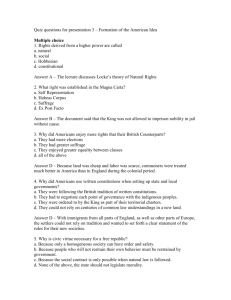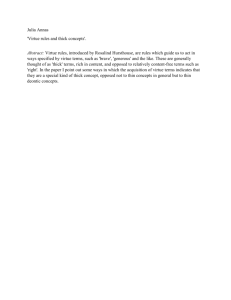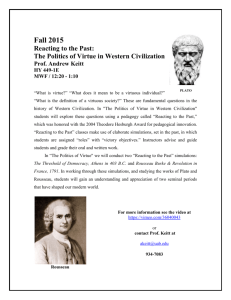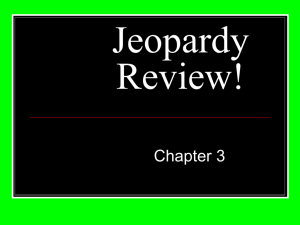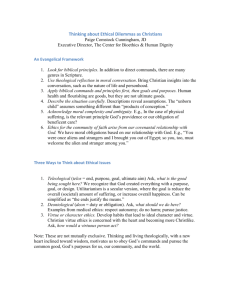The Politics of Virtue - Academic Development Institute
advertisement
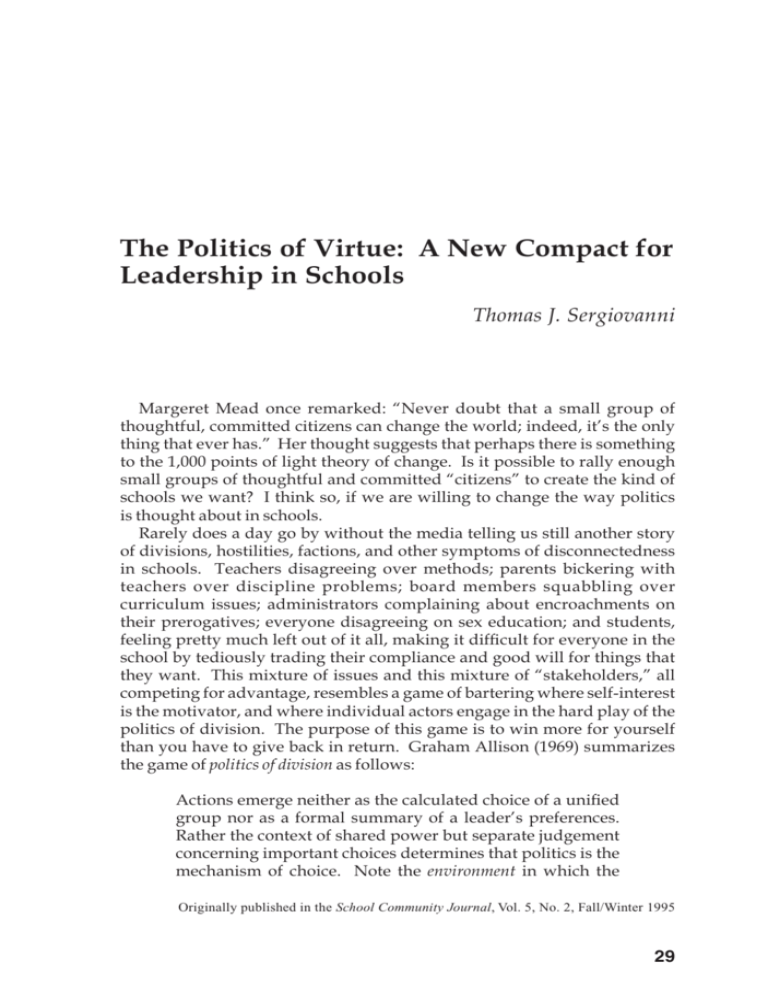
The Politics of Virtue: A New Compact for Leadership in Schools Thomas J. Sergiovanni Margeret Mead once remarked: “Never doubt that a small group of thoughtful, committed citizens can change the world; indeed, it’s the only thing that ever has.” Her thought suggests that perhaps there is something to the 1,000 points of light theory of change. Is it possible to rally enough small groups of thoughtful and committed “citizens” to create the kind of schools we want? I think so, if we are willing to change the way politics is thought about in schools. Rarely does a day go by without the media telling us still another story of divisions, hostilities, factions, and other symptoms of disconnectedness in schools. Teachers disagreeing over methods; parents bickering with teachers over discipline problems; board members squabbling over curriculum issues; administrators complaining about encroachments on their prerogatives; everyone disagreeing on sex education; and students, feeling pretty much left out of it all, making it difcult for everyone in the school by tediously trading their compliance and good will for things that they want. This mixture of issues and this mixture of “stakeholders,” all competing for advantage, resembles a game of bartering where self-interest is the motivator, and where individual actors engage in the hard play of the politics of division. The purpose of this game is to win more for yourself than you have to give back in return. Graham Allison (1969) summarizes the game of politics of division as follows: Actions emerge neither as the calculated choice of a unied group nor as a formal summary of a leader’s preferences. Rather the context of shared power but separate judgement concerning important choices determines that politics is the mechanism of choice. Note the environment in which the Originally published in the School Community Journal, Vol. 5, No. 2, Fall/Winter 1995 29 THE COMMUNITY OF THE SCHOOL game is played: inordinate uncertainty about what must be done, the necessity that something be done and crucial consequences of whatever is done. These features force responsible men to become active players. The pace of the game—hundreds of issues, numerous games, and multiple channels—compels players to ght to “get others’ attention,” to make them “see the facts,” to assure that they “take the time to think seriously about the broader issue.” The structure of the game—power shared by individuals with separate responsibilities—validates each player’s feeling that “others don’t see my problem,” and “others must be persuaded to look at the issue from a less parochial perspective.” The rules of the game—he who hesitates loses his chance to play at that point, and he who is uncertain about his recommendation is overpowered by others who are sure —pressures players to come down on the side of a 51-49 issue and play. The rewards of the game—effectiveness, i.e., impact on outcomes, as the immediate measure of performance—encourages hard play” (p. 710). The politics of division is a consequence of applying formal organization theories of governance, management, and leadership to schools. At root these theories assume that human nature is motivated by self-interest, and that leadership requires the bartering of need fulllment for compliance. Would things be different if we applied community theories instead? Communities, too, “play the game” of politics. But it is a different game. It is a game of politics more like that envisioned by James Madison, Alexander Hamilton, John Jay, Thomas Jefferson, and other American Founders and enshrined in such sacred documents as the Declaration of Independence, the Constitution of the United States, and the amendments to that constitution that represents a bill of rights and a bill of responsibilities for all Americans. It is a game called the politics of virtue—a politics motivated by shared commitment to the common good and guided by protections that ensure the rights and responsibilities of individuals. Civic Virtue Is it possible to replace the politics of division with a politics of virtue? I think so if we are willing to replace the values that have been borrowed from the world of formal organizations with traditional democratic values that encourage a commitment to civic virtue. This would entail development and use of different theories of human nature and leadership. For example, the rational choice theories of human nature we now use will need to be 30 The Politics of Virtue replaced with a normative and moral theory of human nature. And, the executive images of leadership that we now rely upon will need to be replaced with collegial images aimed at problem-solving and ministering. Creating a politics of virtue requires that we renew commitments to the democratic legacy that gave birth to our country. This is the legacy that can provide the foundation for leadership in schools. The American Founders had in mind the creation of a covenantal polity within which: “The body is one but has many members. There can be unity with diversity . . . . The great challenge was to create a political body that brought people together and created a ‘we’ but still enabled people to separate themselves and recognize and respect one another’s individualities. This remains the great challenge for all modern democracies” (Elshtain, 1994, p. 9). The cultivation of commitment to civic virtue is a key part of this challenge. During the debate over passing the constitution of 1787, America was faced with a choice between two conceptions of politics: republican and pluralist. In republican politics civic virtue was considered to be the cornerstone principle—the prerequisite for the newly-proposed government to work. Civic virtue was embodied in the willingness of citizens to subordinate their own private interests to the general good (see for example Sunstein, 1994), and was therefore the basis for creating a politics of virtue. This politics of virtue emphasized self-rule by the people, but not the imposition of their private preferences on the new government. Instead, preferences were to be developed and shaped by the people themselves for the benet of the common good. Haefele (1993) believes that it is easier to provide examples of how civic virtue is expressed than to try to dene it with precision. In his words: It is fashionable nowadays for both the left and the right to decry the loss of civic virtue; the left on such issues as industry rape of the environment and the right because of the loss of patriotism. Both sides are undoubtedly right, as civic virtue belongs to no single party or creed. It is simply a quality of caring about public purposes and public destinations. Sometimes the public purpose is chosen over private purposes. A young Israeli economist investigating a Kibbutz came across the following case. The Kibbutz had money to spend. The alternatives were a TV antennae and TV sets for everyone or a community meeting hall. The economist found that everyone preferred the TV option but that, when they voted, they unanimously chose the meeting hall. Call it enlightened self-interest, a community preference or something else, it is civic virtue in action (p. 211). 31 THE COMMUNITY OF THE SCHOOL When the republican conception of politics is applied to schools, both the unique shared values that dene individual schools as communities, and our common democratic principles and conceptions of goodness that provide the basis for dening civic virtue are important. The pluralist conception of politics differs from the republican. Without the unifying power of civic virtue, factions are strengthened and the politics of division reigns. In the ideal, the challenge of this politics is to play people and events in a way that the self-interests of individuals and factions are mediated in some orderly manner. “Under the pluralist conception, people come to the political process with pre-selected interests that they seek to promote through political conict and compromise” (Sunstein, 1993, p. 176). Deliberate governmental processes of conict resolution and compromise, of checks and balances, are needed in the pluralist view because preferences are not shaped by the people themselves as they strive to control self-interests that happen to dominate at the time. Civic virtue was important to both Federalists, who supported the proposed constitution, and Anti-Federalists, who opposed the constitution, though it was the centerpiece of Anti-Federalist thinking. The AntiFederalists favored decentralization in the form of democracy tempered by a commitment to the common good. The Federalists, by contrast, acknowledged the importance of civic virtue, but felt the pull of pluralistic politics was too strong for the embodiment of virtue to be left to chance. They proposed a representative rather than a direct form of government that would be guided by the principles of a formal constitution that specied a series of governmental checks and balances to control factionalism and self-interest. Both the positions of the Federalists and the Anti-Federalists have roles to play in the governance of schools. In small communities, for example, the politics of virtue expressed within a direct democracy that is guided by citizen devotion to the public good seems to make the most sense. Small schools and small schools within schools would be examples of such communities. They would be governed by autonomous school councils that are responsible for both educational policy and site-based management—both ends and means. This approach to governance represents a significant departure from present policies that allow principals, parents, and teachers in local schools to decide how they will do things, but not what they will do. The decisions that local school councils make would be guided by shared values and beliefs that parents, teachers, and students develop together. Schools, in this image, would not function as markets where self-interests reign or bureaucracies where entrenched rule systems reign, but as morally-based direct democracies within which parents, teachers, and students, guided by civic virtue, make the best decisions possible for learning. 32 The Politics of Virtue At the school district level, by contrast, the position of the Federalists might make the most sense. A representative form of government spearheaded by elected school boards guided by an explicit constitution that contains the protections and freedoms needed to enable individual school communities to function both responsibly and autonomously, would be the model. School communities would have to abide by certain school district regulations regarding safety, due process, equity, scal procedures, and a few basic academic standards. But beyond these, schools would be free to decide for themselves not only their management processes, but their policy structures as well. They would be responsible for deciding their own educational purposes, their own educational programs, their own scheduling and ways of operating, and their own means to demonstrate to the school district and to the public that they are functioning responsibly. Accountability in such a system would be both responsive to each school’s purposes and, in light of those purposes, to tough standards of proof. How can schools be held accountable for different standards? First we will need to create standards for standards. Then we will be able to assess whether the standards that individual schools set for themselves are good ones. Once standards are accepted, each school is then assessed on its own terms. Here is how such a strategy would work: Schools make promises to the people; the promises must be good ones; school boards and states hold schools accountable for keeping their promises. The Rational Choice Question Formal organization theories of human nature can be traced back to a few principles that are at the center of classical economic theory. Prime among them is the utility function which is believed to explain all consumer behavior. The reasoning behind this belief is as follows: humans are by their nature selsh. They are driven by a desire to maximize their self-interests and thus continually calculate the costs and benets of their actions. They choose courses of action that either make them winners (they get a desired payoff) or keep them from losing (they avoid penalties). So dominant is this view and so pervasive is the concept of utility function that emotions such as love, loyalty, obligation, sense of duty, belief in goodness, commitment to a cause, and a desire to help make things better are thought to count very little in determining the courses of actions that humans choose. This view of human nature comprises a model of economics called Rational Choice Theory. Rational Choice Theory, expressed simply as “What gets rewarded gets done,” undergirds much of the thinking in schools about how to motivate teachers to perform, how to introduce school improvement initiatives in schools, how to motivate people to accept change, and how to motivate 33 THE COMMUNITY OF THE SCHOOL students to learn and to behave. By emphasizing self-interest, Rational Choice Theory discourages the development of civic virtue. Two additional motivational rules need to be recognized if we are to have a more complete picture of human nature: “What is rewarding gets done,” and “What people value and believe in gets done.” Both rules compel people to perform, to improve, to change, and to meet their commitments from within even if doing so requires that self-interest be sacriced. Both rules address the intrinsic and moral nature of human nature. Both rules are essential to the cultivation of civic virtue. Is Civic Virtue for Students, Too? Some readers might concede that perhaps we should move away from a rational choice view of motivation. Perhaps we should acknowledge the capacity of parents and teachers to respond less in terms of their self-interest, and more in terms of what they believe is right and good. But what about students? Can they too respond to the call of virtue? Children and young adults in schools have different needs and different dispositions. They function developmentally at different levels of moral reasoning than do adults. But the evidence is clear that students from kindergarten to grade twelve have the capacity to understand what civic virtue is and have the capacity to respond to it in ways that are consistent with their own levels of maturation. Rose Reissman (1993) and several other teachers in New York City’s District 25, for example , have been working with elementary school children (even rst and second graders) on developing “bills of responsibilities.” The bills are designed to teach the meaning of civic virtue, and to introduce students to sources of authority that are more morally based than the usual behavioristic ways to get students to do things. Key is the emphasis on reciprocal responsibilities—a critical ingredient in community building. Communities of mind, for example, evolve from commitments to standards that apply to everyone in the school, not just to students. Thus if students must be respectful, so must parents, teachers, principals, and everyone else who is a member of the school community, or who visits the school. Recent events at the Harmony School in Bloomington, Indiana, illustrate civic virtue in action (Panasonic Foundation, Inc., 1994). A well known sculptor had removed his limestone rhinoceros from its place in front of an art gallery in Bloomington to keep it from being vandalized. The kindergarten-through-twelfth-grade students at the Harmony School launched a campaign to return the rhino to Bloomington . They raised $6,000 and purchased the rhino which now stands in front of the school for the entire community to enjoy. In 1993, Harmony High School students decided that instead of the 34 The Politics of Virtue traditional eld trip to Chicago, they would go to Quincy, Illinois, where the Mississippi oods had devastated the city. One of the students explained, “They have plenty of food, and plenty of relief supplies, but they don’t have anybody to help get life in order.” Harmony students helped by clearing mud, garbage and debris from the streets, and by planting owers and shrubs. Many similar stories, I know, are coming to your mind as you read about and think about the events at Harmony. Harmony School is private, and Bloomington, Indiana, is hardly downtown Kansas City, Miami, or San Antonio. But students everywhere are pretty much the same. They have the capacity to care. They want to be called to be good, and they know the difference between right and wrong. The fact is that students, too, under the right conditions, not only will be responsive to the calls of civic virtue, but they need to be responsive if they are to develop into the kinds of adults we want them to be. New Leadership Images Replacing the politics of division with a politics of virtue requires a redened leadership. Civic virtue is encouraged when leadership aims to develop a web of moral obligations that administrators, teachers, parents, and even students must accept. One part of this obligation is to share in the responsibility for exercising leadership. Another part of this obligation is to share in the responsibility for ensuring that leadership, whatever its source, is successful. In this redenition, teachers continue to be responsible for providing leadership in classrooms. But students too have a moral obligation to help make things work. They too provide leadership where they can, and they too try as best they can to make the teacher’s leadership effective. Similarly, administrators, parents, and teachers would accept responsibility together for the provision and the success of leadership. Key to leadership in a democracy is the concept of social contract. Ronald Heifetz (1994) notes, “In part, democracy requires that average citizens become aware that they are indeed the principals, and that those upon whom they confer power are the agents. They have also to bear the risks, the costs, and the fruits of shared responsibility and civic participation” (p. 61). It is through morally-held role responsibilities that we can understand school administration as a profession in its more traditional sense. School administration is bound not just to standards of technical competence, but to standards of public obligation as well (Bellah, 1985). The primacy of public obligation leads us to the roots of school leadership—stewardship dened as a commitment to administer the needs of the school by serving its purposes, by serving those who struggle to embody these purposes, and by acting as a guardian to protect the institutional integrity of the school. 35 THE COMMUNITY OF THE SCHOOL Principals function as stewards by providing for the overseeing and caring of their schools. As stewards, they are not so much managers or executives but administrators. According to Webster, to “manage” means to handle, to control, to make submissive, to direct an organization. “Superintend,” in turn, means attending to, giving attention to, having oversight over what is intended. It means, in other words, supervision. As “supervisor” the principal acts in loco parentis in relationship to students, ensuring that all is well for them. And as supervisor the principal acts as steward, guarding and protecting the school’s purposes and structures. Supervision in communities implies accountability, but not in the tough, inspectoral sense suggested by factory images of inspection and control. Instead, it implies an accountability embedded in tough and tender caring. Principals care enough about the school, about the values and purposes that undergird it, about the students who are being served, about the parents who they represent, about the teachers upon whom they depend, that they will do whatever they can to protect school values and purposes on the one hand, and to enable their accomplishment on the other. In a recent interview Deborah Meier, then co-director of the celebrated Central Park East Secondary School in New York City, was asked, “What is the role of the principal in an effective school?” (Scherer, 1994). Her response shows how the various ministerial roles of the principal are brought together by supervision understood as an expression of stewardship: Someone has to keep an eye on the whole and alert everyone when parts need close- or long-range attention. A principal’s job is to put forth to the staff an agenda. The staff may or may not agree, but they have an opportunity to discuss it. I’ll say, ‘Listen, I’ve been around class after class, and I notice this, don’t notice this, we made a commitment to be accountable for one another, but I didn’t see anybody visiting anybody else’s class. . . . Paul [Schwartz, Meier’s co-director] and I also read all the teacher’s assessments of students. Once we noticed that the 9th and the 10th grade math teachers often said the kids didn’t seem to have an aptitude for math. We asked the math staff, ‘How can these kids do nicely in 7th and 8th grade, and then seem inept in 9th and 10th? Are we fooling ourselves in 7th and 8th, or are we fooling ourselves in 9th and 10th? Because they are the same kids’ (p. 7). Meier and Schwartz both practiced leadership that is idea-based. The source of authority they appealed to are the values that are central to the school, and the commitments that everyone has made to them. And because of this, their supervisory responsibilities do not compromise democratic 36 The Politics of Virtue principles, dampen teacher empowerment, or get in the way of community building. Both directors were committed to creating a staff-run school with high standards—one where staff must know each other, be familiar with each other’s work, and know how the school operates. As Meier (1992) explained, “Decisions are made as close to each teacher’s own classroom setting as possible, although all decisions are ultimately the responsibility of the whole staff. The decisions are not merely on minor matters--length of classes or the number of eld trips. The teachers collectively decide on content, pedagogy, and assessment as well. They teach what they think matters . . . governance is simple. There are virtually no permanent standing committees. Finally, we work together to develop assessment systems for our students, their families, ourselves, and the broader public. Systems that represent our values and beliefs in as direct a manner as possible” (p. 607). This process of shared decision-making is not institutionalized into a formal system, but is embedded in the daily interactions of everyone working together. In stewardship the legitimacy of leadership comes in part from the virtuous responsibilities associated with the principal’s role, and in part from the principal’s obligation to function as the head follower of the school’s moral compact. In exercising these responsibilities and obligations it is not enough to make the right moves for just any purpose or just any vision. The noted historian and leadership theorist James MacGregor Burns (1978) pointed out that purposes and visions should be socially useful, should serve the common good, should meet the needs of followers, and should elevate followers to a higher moral level. He calls this kind of leadership transformational. Many business writers and their imitators in educational administration have secularized this original denition of Transformational Leadership to make it more suitable to the values of formal organizations. They “conceive of transformation, not in Burns’s sense of elevating the moral functioning of a polity, but in the sense of inspiration, intellectual stimulation, and personal considerations . . ., or altering the basic normative principals that guide an institution . . .” (Heifetz, 1994, pp. 228-289; see also Bass, 1985; Hargrove, 1989). This revisionist concept of Transformational Leadership might be alright for managers and CEOs in business organizations. But when it comes to the kind of leadership they want for their children’s schools, few business persons are likely to prefer the corporate denition over Burns’s original denition. When principals practice leadership as stewardship, they commit themselves to building, to serving, to caring for, and to protecting the school and its purposes. They commit themselves to helping others to face problems, and to helping others to make progress in getting problems solved. Leadership as stewardship asks a great deal of leaders and followers 37 THE COMMUNITY OF THE SCHOOL alike. It calls both to higher levels of commitment. It calls both to higher levels of goodness. It calls both to higher levels of effort. And it calls both to higher levels of accountability. Leadership as stewardship is the sine qua non for cultivating civic virtue. Civic virtue can help transform individual stakeholders into members of a community who share common commitments and who feel a moral obligation to help each other embody those commitments. References Allison, G.T. (1969). Conceptual models and the Cuban missile crisis. The American Political Science Review, 63(3), 689-718. Bass, B. M. (1985). Leadership and performance beyond expectations. New York: Free Press. Bellah, R. N. and others. (1985). Habits of the heart: Individualism and commitment in American life. New York: Harper Collins. Burns, J. M. (1978). Leadership. New York: Harper Collins. Elshtain, J. B. (1994). Democracy and the politics of difference. The Responsive Community, 4 (2), 9-20. Haefele, E. T. (1993). What constitutes the American republic? In S. L. Elkin and K. E. Soltan, A new constitutionalism (pp. 207-233). Chicago: The University of Chicago Press. Hargrove, E. C. (1989). Two conceptions of institutional leadership. In B.D. Jones (Ed.), Leadership and politics: New perspectives in political science. Lawrence: University of Kansas Press. Heifetz, R. (1984). Leadership no easy answers. Cambridge, Mass.: Belknap Press. Meier, D. (1992). Reinventing teaching. Teacher’s College Record, 93(4), 594-609. Panasonic Foundation. (1994). Panasonic partnership program: A newsletter of the Panasonic Foundation, 4 (1). Reissman, R. (1993). A bill of responsibilities. Educational Leadership, 51(4), 86-87. Samuelson, P. (1947). Foundations of economic analysis. Cambridge, MA.: Harvard University Press. Sunstein, C. R. (1993). The enduring legacy of republicanism. In S. L. Elkin and K. E. Soltan, A New Constitutionalism (pp. 174-207). Chicago: The University of Chicago Press. van Mannen, M. (1991). The tact of teaching: The meaning of pedagogical thoughtfulness. Albany: State University of New York Press. Note: This article is drawn from Leadership for the Schoolhouse: How Is It Different? Why Is It Important? San Francisco: Jossey-Bass, 1996. Thomas J. Sergiovanni is the Lillian Radford professor of education and administration at Trinity University, San Antonio, Texas. 38
